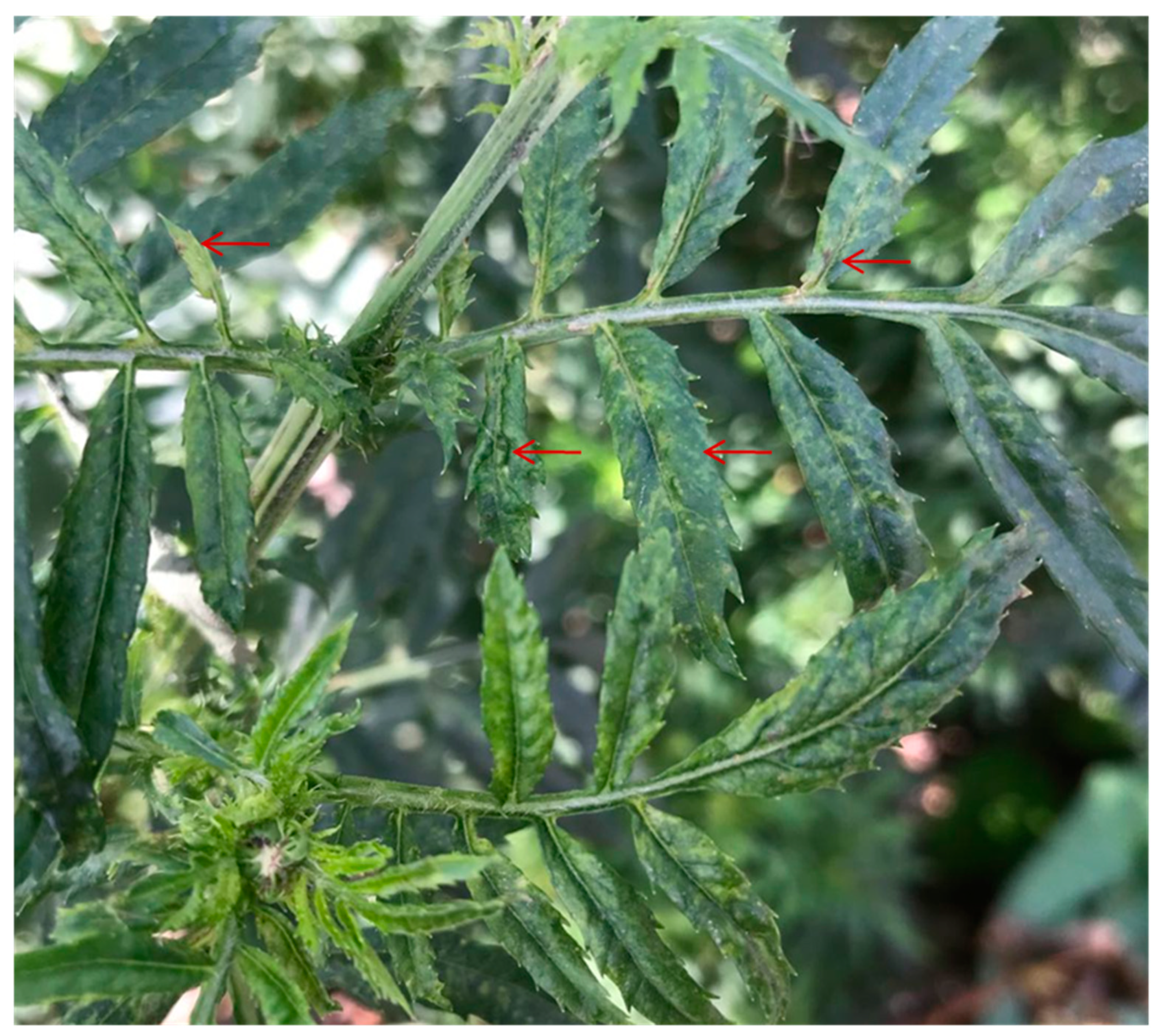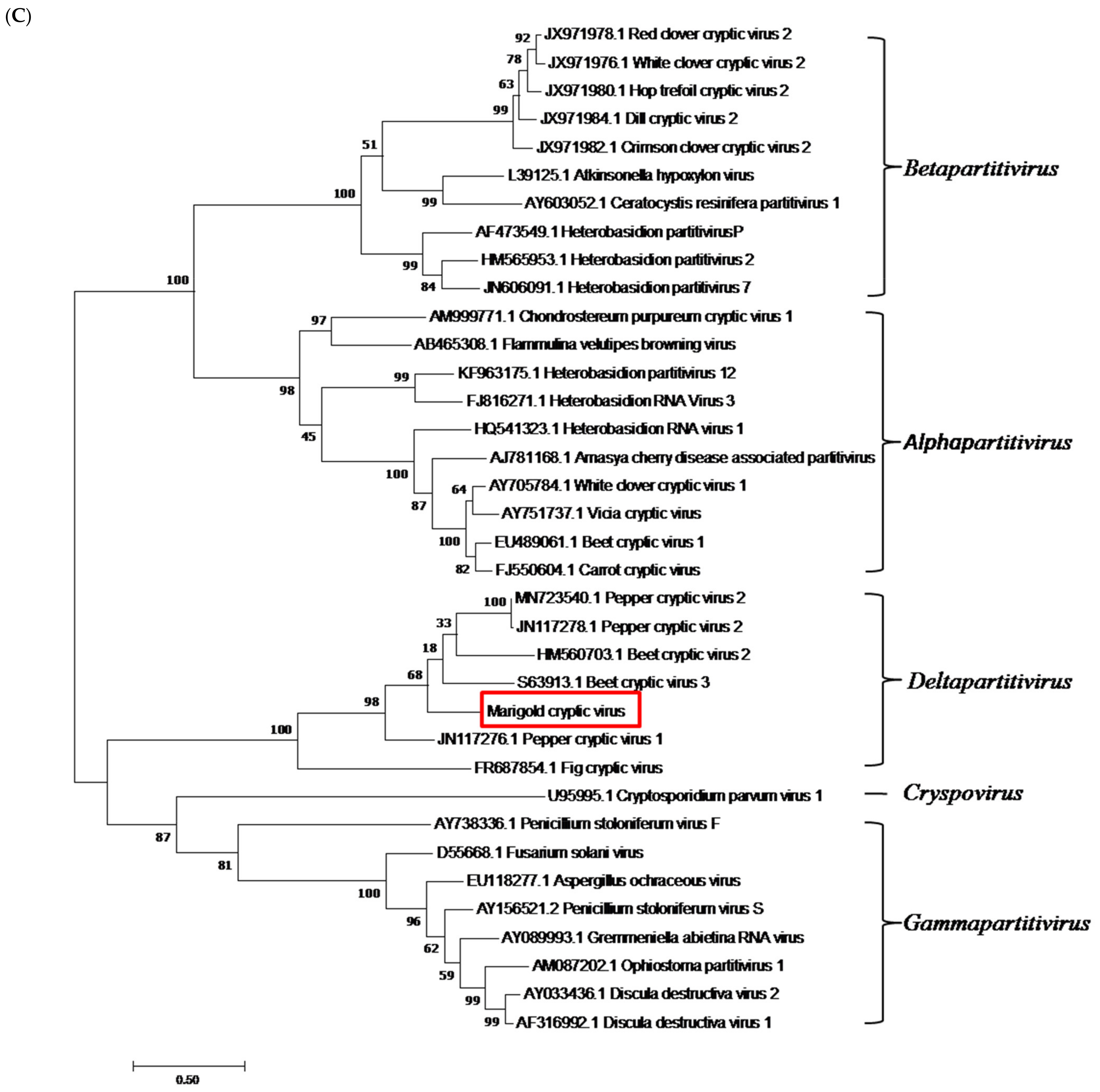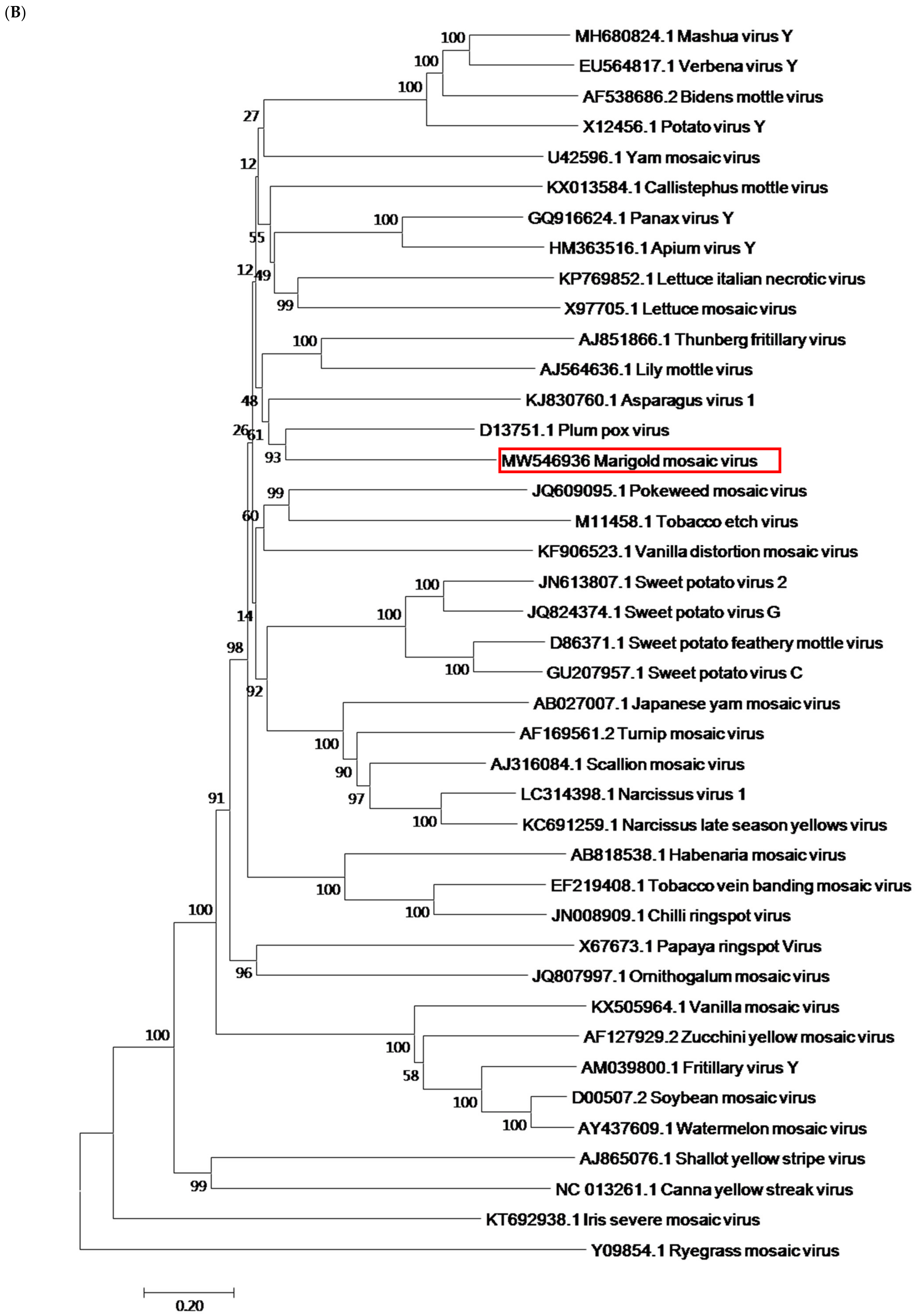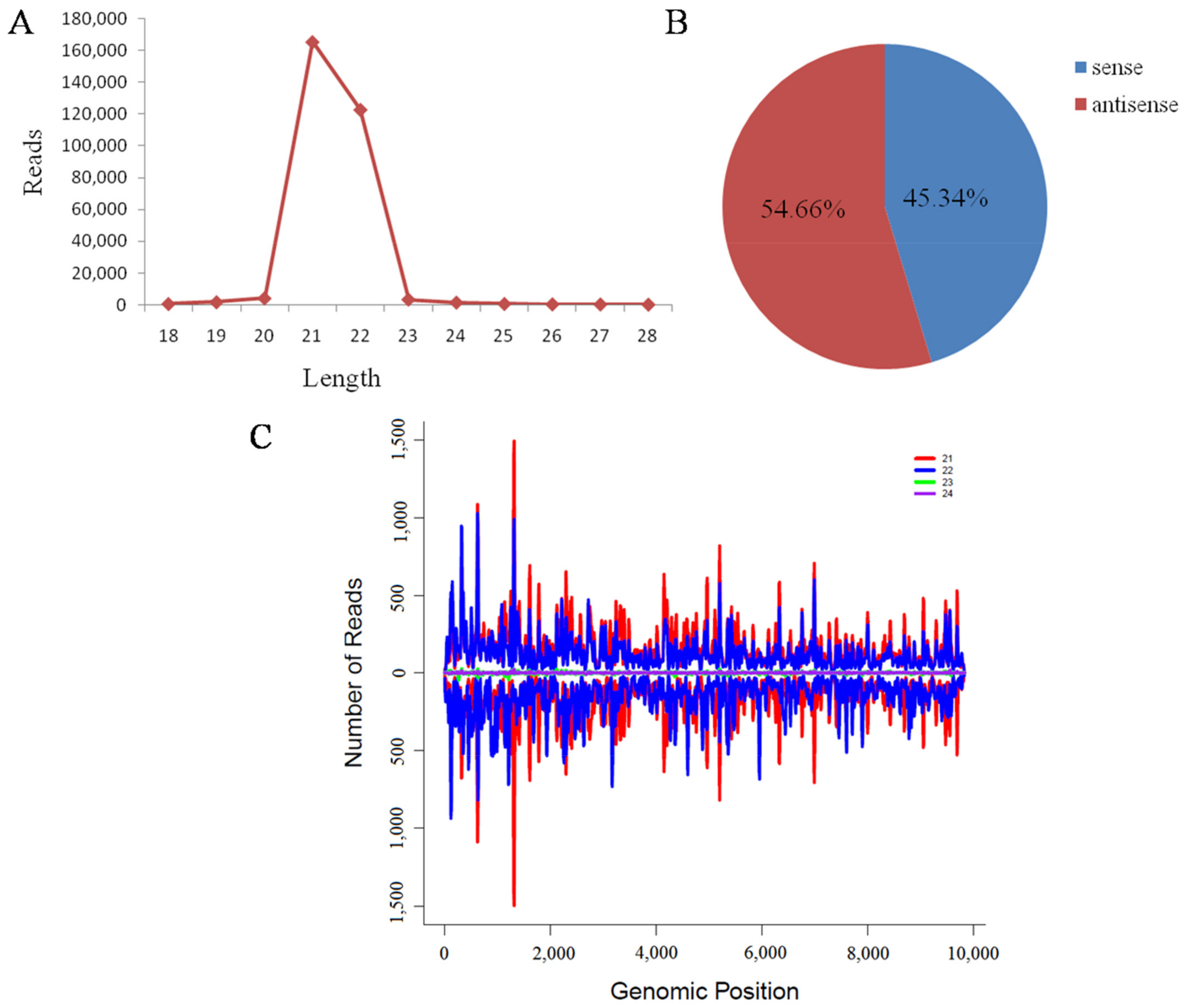Metagenomic Analysis of Marigold: Mixed Infection Including Two New Viruses
Abstract
:1. Introduction
2. Materials and Methods
2.1. Plant Materials
2.2. Library Construction, Deep Sequencing and Bioinformatic Analysis
2.3. Genome Sequence Reconstruction of Candidate New Viruses
2.4. Sequence Analysis
2.5. Field Detection of Candidate Viruses
3. Results
3.1. Deep Sequencing Analyses
3.2. Three Known Viruses in Marigold-CMV, BBWV-2 and TuMV
3.3. A potential New Member in Deltapartitivirus-Marigold Cryptic Virus
3.4. Characterization of a New Potyvirus-Marigold Mosaic Virus
3.5. Characterization of Small RNAs Derived from Marigold Mosaic Virus
3.6. Field Distribution of Candidate Viruses
4. Discussion
5. Conclusions
Supplementary Materials
Author Contributions
Funding
Institutional Review Board Statement
Informed Consent Statement
Data Availability Statement
Conflicts of Interest
References
- Patil, B.L. Plant Viral Diseases: Economic Implications. In Encyclopedia of Virology, 4th ed.; Bamford, D.H., Zuckerman, M., Eds.; Academic Press: Oxford, UK, 2021; Volume 3, pp. 81–97. [Google Scholar]
- Maree, H.J.; Fox, A.; Al Rwahnih, M.; Boonham, N.; Candresse, T. Application of HTS for Routine Plant Virus Diagnostics: State of the Art and Challenges. Front. Plant Sci. 2018, 9, 1082. [Google Scholar] [CrossRef] [Green Version]
- Villamor, D.E.V.; Ho, T.; Al Rwahnih, M.; Martin, R.R.; Tzanetakis, I.E. High Throughput Sequencing For Plant Virus Detection and Discovery. Phytopathology 2019, 109, 716–725. [Google Scholar] [CrossRef]
- Roossinck, M.J. Deep sequencing for discovery and evolutionary analysis of plant viruses. Virus Res. 2017, 239, 82–86. [Google Scholar] [CrossRef]
- Candresse, T.; Filloux, D.; Muhire, B.; Julian, C.; Galzi, S.; Fort, G.; Bernardo, P.; Daugrois, J.-H.; Fernandez, E.; Martin, D.P.; et al. Appearances Can Be Deceptive: Revealing a Hidden Viral Infection with Deep Sequencing in a Plant Quarantine Context. PLoS ONE 2014, 9, e102945. [Google Scholar] [CrossRef] [Green Version]
- Martin, R.R.; Constable, F.; Tzanetakis, I.E. Quarantine Regulations and the Impact of Modern Detection Methods. Annu. Rev. Phytopathol. 2016, 54, 189–205. [Google Scholar] [CrossRef] [Green Version]
- Rwahnih, M.A.; Rowhani, A.; Smith, R.J.; Uyemoto, J.K.; Sudarshana, M.R. Grapevine necrotic union, a newly recognized disease of unknown etiology in grapevines grafted on 110 richter rootstock in California. J. Plant Pathol. 2012, 94, 149–156. [Google Scholar]
- Batuman, O.; Çiftçi, Ö.C.; Osei, M.K.; Miller, S.A.; Rojas, M.R.; Gilbertson, R.L. Rasta Disease of Tomato in Ghana is Caused by the Pospiviroids Potato spindle tuber viroid and Tomato apical stunt viroid. Plant Dis. 2019, 103, 1525–1535. [Google Scholar] [CrossRef] [PubMed] [Green Version]
- Verdin, E.; Wipf-Scheibel, C.; Gognalons, P.; Aller, F.; Jacquemond, M.; Tepfer, M. Sequencing viral siRNAs to identify previously undescribed viruses and viroids in a panel of ornamental plant samples structured as a matrix of pools. Virus Res. 2017, 241, 19–28. [Google Scholar] [CrossRef] [PubMed] [Green Version]
- Zhang, Z.-C.; Hu, S.-H.; Peng, Y.-Q.; Yan, H.-S.; Xiao, F.; Gao, J.; Wu, J.-J.; Zhou, X.; Xu, X.-Y.; Xu, L.; et al. The complete chloroplast genome of Mexican marigold (Tageteserecta L., Asteraceae). Mitochondrial DNA Part B 2019, 4, 3587–3588. [Google Scholar] [CrossRef] [PubMed] [Green Version]
- Tiwary, B.K.; Kumar, A.; Nanda, A.K.; Chakraborty, R. A study on optimization of marigold petal yield, pure lutein, and formulation of free-flowing lutein esters. J. Crop. Sci. Biotechnol. 2014, 17, 175–181. [Google Scholar] [CrossRef]
- Negi, J.S.; Bisht, V.K.; Bhandari, A.K.; Sundriyal, R.C. Essential Oil Contents and Antioxidant Activity of Tagetes patula L. J. Essent. Oil Bear. Plants 2013, 16, 364–367. [Google Scholar] [CrossRef]
- Li, W.; Gao, Y.; Zhao, J.; Wang, Q. Phenolic, Flavonoid, and Lutein Ester Content and Antioxidant Activity of 11 Cultivars of Chinese Marigold. J. Agric. Food Chem. 2007, 55, 8478–8484. [Google Scholar] [CrossRef] [PubMed]
- Olabiyi, T.I.; Oyedunmade, E.E.A. Marigold (Tageteserecta L.) as interplant with cowpea for the control of nematode pests. Afr. Crop Sci. Conf. Proc. 2007, 8, 1075–1078. [Google Scholar]
- Marwal, A.; Sahu, A.K.; Choudhary, D.K.; Gaur, R.K. Complete nucleotide sequence of a begomovirus associated with satellites molecules infecting a new host Tagetespatula in India. Virus Genes 2013, 47, 194–198. [Google Scholar] [CrossRef] [PubMed]
- Singh, D.; Naqvi, Q.A.; Garg, I.D. A strain of cucumber mosaic cucumovirus causing mosaic in marigold in India. Indian Phytopath. 1999, 52, 114–117. [Google Scholar]
- Sultana, R.; Akanda, A.M.; Haque, M.A.S.; Majumdar, A.; Munsur, M.A.Z.A. An Investigation to Virus like Diseases of Marigold. J. Biosci. Agric. Res. 2014, 2, 23–35. [Google Scholar] [CrossRef] [Green Version]
- Bhardwaj, S.V.; Mehra, A.; Handa, A.; Jyotsana, S.; Bhatnagar, M. Production of virus free plants of African marigold (Tageteserecta L.) through shoot meristem culture. In Integrated Plant Disease Management. Challenging Problems in Horticultural and Forest Pathology; Sharma, R.C., Sharma, J.N., Eds.; Jodhpur: Solan, India, 2005; pp. 247–251. [Google Scholar]
- Lockhart, B.E.L. Recurrence of naturally occurring potato yellow dwarf virus in Minnesota. Plant Dis. 1989, 73, 321–323. [Google Scholar] [CrossRef]
- Salazar, L.F.; Müller, G.; Querci, M.; Zapata, J.L.; Owens, R.A. Potato yellow vein virus: Its host range, distribution in South America and identification as a crinivirus transmitted by Trialeurodes vaporariorum. Ann. Appl. Biol. 2000, 137, 7–19. [Google Scholar] [CrossRef]
- Rao, R.D.V.J.P.; Reddy, A.S.; Reddy, S.V.; Thirumala-Devi, K.; Rao, S.C.; Kumar, V.M.; Subramaniam, K.; Reddy, T.Y.; Nigam, S.N.; Reddy, D.V.R. The host range of Tobacco streak virus in India and transmission by thrips. Ann. Appl. Biol. 2003, 142, 365–368. [Google Scholar] [CrossRef] [Green Version]
- Ghotbi, T. First report on incidence of tobacco streak virus (TSV) on ornamental plants in Iran. Iranian J Plant Pathol. 2006, 42, 159–160. [Google Scholar]
- Bakardjieva, N.; Denkova, S.; Hristova, D. Tomato spotted wilt virus on ormamental species in Bulgaria. Biotech. Biotechnol. Equip. 1998, 12, 49–52. [Google Scholar] [CrossRef] [Green Version]
- Chatzivassiliou, E.K.; Livieratos, I.; Jenser, G.; Katis, N.I. Ornamental plants and thrips populations associated with tomato spotted wilt virus in Greece. Phytoparasitica 2000, 28, 257–264. [Google Scholar] [CrossRef]
- Moini, A.A.; Izadpanah, K. New hosts for Tomato spotted wilt virus in Tehran. Iranian J. Plant Pathol. 2000, 36, 104–105. [Google Scholar]
- Parrella, G.; Gognalons, P.; Gebre-Selassi, K.; Vovlas, C.; Marchoux, G. An update of the host range of tomato spotted wilt virus. J. Plant Pathol. 2003, 85, 227–264. [Google Scholar]
- Ghotbi, T.; Shahraeen, N.; Winter, S. Occurrence of Tospoviruses in Ornamental and Weed Species in Markazi and Tehran Provinces in Iran. Plant Dis. 2005, 89, 425–429. [Google Scholar] [CrossRef] [Green Version]
- Chen, Y.; Chen, Y.; Shi, C.; Huang, Z.; Zhang, Y.; Li, S.; Li, Y.; Ye, J.; Yuxin, C.; Li, Z.; et al. SOAPnuke: A MapReduce acceleration-supported software for integrated quality control and preprocessing of high-throughput sequencing data. GigaScience 2018, 7, 1–6. [Google Scholar] [CrossRef] [Green Version]
- Grabherr, M.G.; Haas, B.J.; Yassour, M.; Levin, J.Z.; A Thompson, D.; Amit, I.; Adiconis, X.; Fan, L.; Raychowdhury, R.; Zeng, Q.; et al. Full-length transcriptome assembly from RNA-Seq data without a reference genome. Nat. Biotechnol. 2011, 29, 644–652. [Google Scholar] [CrossRef] [PubMed] [Green Version]
- Thompson, J.D.; Higgins, D.G.; Gibson, T.J. CLUSTALW: Improving the sensitivity of progressive multiple sequence alignment through sequence weighting, position-specific gap, penalties and weight matrix choice. Nucleic Acids Res. 1994, 22, 4673–4680. [Google Scholar] [CrossRef] [PubMed] [Green Version]
- Tamura, K.; Stecher, G.; Kumar, S. MEGA11: Molecular Evolutionary Genetics Analysis Version 11. Mol. Biol. Evol. 2021, 30, 2725–2729. [Google Scholar] [CrossRef] [Green Version]
- Bruenn, J.A. A closely related group of RNA-dependent RNA polymerases from double-stranded RNA viruses. Nucleic Acids Res. 1993, 21, 5667–5669. [Google Scholar] [CrossRef] [PubMed]
- Lesker, T.; Rabenstein, F.; Maiss, E. Molecular characterization of five betacryp-toviruses infecting four clover species and dill. Arch. Virol. 2013, 158, 1943–1952. [Google Scholar] [CrossRef] [PubMed]
- Chung, B.Y.-W.; Miller, W.A.; Atkins, J.; Firth, A.E. An overlapping essential gene in the Potyviridae. Proc. Natl. Acad. Sci. USA 2008, 105, 5897–5902. [Google Scholar] [CrossRef] [PubMed] [Green Version]
- Valli, A.; López-Moya, J.J.; García, J.A. Recombination and gene duplication in the evolutionary diversification of P1 proteins in the family Potyviridae. J. Gen. Virol. 2007, 88, 1016–1028. [Google Scholar] [CrossRef] [PubMed]
- Atreya, C.D.; Pirone, T.P. Mutational analysis of the helper component-proteinase gene of a potyvirus: Effects of amino acid substitutions, deletions, and gene replacement on virulence and aphid transmissibility. Proc. Natl. Acad. Sci. USA 1993, 90, 11919–11923. [Google Scholar] [CrossRef] [PubMed] [Green Version]
- Riechmann, J.L.; Lain, S.; García, J.A. Highlights and prospects of potyvirus molecular biology. J. Gen. Virol. 1992, 73, 1–16. [Google Scholar] [CrossRef]
- Kadaré, G.; Haenni, A.L. Virus-encoded RNA helicases. J. Virol. 1997, 71, 2583–2590. [Google Scholar] [CrossRef] [Green Version]
- Dougherty, W.G.; Parks, T.; Cary, S.M.; Bazan, J.; Fletterick, R.J. Characterization of the catalytic residues of the tobacco etch virus 49-kDa proteinase. Virology 1989, 172, 302–310. [Google Scholar] [CrossRef]
- Atreya, C.; Raccah, B.; Pirone, T. A point mutation in the coat protein abolishes aphid transmissibility of a potyvirus. Virology 1990, 178, 161–165. [Google Scholar] [CrossRef]
- Dujovny, G.; Sasaya, T.; Koganesawa, H.; Usugi, T.; Shohara, K.; Lenardon, S.L. Molecular characterization of a new potyvirus infecting sunflower. Arch. Virol. 2000, 145, 2249–2258. [Google Scholar] [CrossRef]
- Wylie, S.J.; Adams, M.; Chalam, C.; Kreuze, J.; López-Moya, J.J.; Ohshima, K.; Praveen, S.; Rabenstein, F.; Stenger, D.; Wang, A.; et al. ICTV Virus Taxonomy Profile: Potyviridae. J. Gen. Virol. 2017, 98, 352–354. [Google Scholar] [CrossRef]
- Li, Y.; Deng, C.; Shang, Q.; Zhao, X.; Liu, X.; Zhou, Q. Characterization of siRNAs derived from cucumber green mottle mosaic virus in infected cucumber plants. Arch. Virol. 2015, 161, 455–458. [Google Scholar] [CrossRef] [PubMed]
- Li, M.; Li, Y.; Xia, Z.; Di, D.; Zhang, A.; Miao, H.; Zhou, T.; Fan, Z. Characterization of small interfering RNAs derived from Rice black streaked dwarf virus in infected maize plants by deep sequencing. Virus Res. 2017, 228, 66–74. [Google Scholar] [CrossRef]
- Roossinck, M.J.; Martin, D.P.; Roumagnac, P. Plant Virus Metagenomics: Advances in Virus Discovery. Phytopathology 2015, 105, 716–727. [Google Scholar] [CrossRef] [PubMed] [Green Version]
- Massart, S.; Olmos, A.; Jijakli, H.; Candresse, T. Current impact and future directions of high throughput sequencing in plant virus diagnostics. Virus Res. 2014, 188, 90–96. [Google Scholar] [CrossRef] [PubMed]
- Zarreen, F.; Kumar, G.; Johnson, A.M.A.; Dasgupta, I. Small RNA-based interactions between rice and the viruses which cause the tungro disease. Virology 2018, 523, 64–73. [Google Scholar] [CrossRef] [PubMed]
- Pecman, A.; Kutnjak, D.; Gutiérrez-Aguirre, I.; Adams, I.; Fox, A.; Boonham, N.; Ravnikar, M. Next Generation Sequencing for Detection and Discovery of Plant Viruses and Viroids: Comparison of Two Approaches. Front. Microbiol. 2017, 8, 1998. [Google Scholar] [CrossRef] [Green Version]
- Visser, M.; Bester, R.; Burger, J.T.; Maree, H.J. Next-generation sequencing for virus detection: Covering all the bases. Virol. J. 2016, 13, 85. [Google Scholar] [CrossRef] [Green Version]
- Roossinck, M.J. Evolutionary History of Cucumber Mosaic Virus Deduced by Phylogenetic Analyses. J. Virol. 2002, 76, 3382–3387. [Google Scholar] [CrossRef] [Green Version]
- Ohshima, K.; Yamaguchi, Y.; Hirota, R.; Hamamoto, T.; Tomimura, K.; Tan, Z.; Sano, T.; Azuhata, F.; Walsh, J.A.; Fletcher, J.; et al. Molecular evolution of Turnip mosaic virus: Evidence of host adaptation, genetic recombination and geographical spread. J. Gen. Virol. 2002, 83, 1511–1521. [Google Scholar] [CrossRef]
- Tan, Z.; Wada, Y.; Chen, J.; Ohshima, K. Inter- and intralineage recombinants are common in natural populations of Turnip mosaic virus. J. Gen. Virol. 2004, 85, 2683–2696. [Google Scholar] [CrossRef]
- Yu, X.-Q.; Lan, Y.-F.; Wang, H.-Y.; Liu, J.-L.; Zhu, X.-P.; Valkonen, J.P.T.; Li, X.-D. The complete genomic sequence of Tobacco vein banding mosaic virus and its similarities with other potyviruses. Virus Genes 2007, 35, 801–806. [Google Scholar] [CrossRef]
- Revers, F.; García, J.A. Molecular Biology of Potyviruses. Adv. Virus Res. 2015, 92, 101–199. [Google Scholar] [PubMed]
- Vainio, E.J.; Chiba, S.; Ghabrial, S.A.; Maiss, E.; Roossinck, M.; Sabanadzovic, S.; Suzuki, N.; Xie, J.; Nibert, M. ICTV Report Consortium ICTV Virus Taxonomy Profile: Partitiviridae. J. Gen. Virol. 2018, 99, 17–18. [Google Scholar] [CrossRef]
- Telengech, P.; Hisano, S.; Mugambi, C.; Hyodo, K.; Arjona-López, J.M.; Herrera, C.J.L.; Kanematsu, S.; Kondo, H.; Suzuki, N. Diverse Partitiviruses from the Phytopathogenic Fungus, Rosellinianecatrix. Front. Microbiol. 2020, 11, 1064. [Google Scholar] [CrossRef]
- Fujita, R.; Inoue, M.N.; Takamatsu, T.; Arai, H.; Nishino, M.; Abe, N.; Itokawa, K.; Nakai, M.; Urayama, S.-I.; Chiba, Y.; et al. Late Male-Killing Viruses in Homonamagnanima Identified as Osugoroshi Viruses, Novel Members of Partitiviridae. Front. Microbiol. 2021, 11. [Google Scholar] [CrossRef] [PubMed]
- Nakatsukasa-Akune, M.; Yamashita, K.; Shimoda, Y.; Uchiumi, T.; Abe, M.; Aoki, T.; Kamizawa, A.; Ayabe, S.-I.; Higashi, S.; Suzuki, A. Suppression of Root Nodule Formation by Artificial Expression of the TrEnodDR1 (Coat Protein of White clover cryptic virus 1) Gene in Lotus japonicus. Mol. Plant-MicrobeInteract. 2005, 18, 1069–1080. [Google Scholar] [CrossRef] [PubMed]
- Roossinck, M.J. Lifestyles of plant viruses. Philos. Trans. R. Soc. B Biol. Sci. 2010, 365, 1899–1905. [Google Scholar] [CrossRef] [Green Version]
- Righetti, L.; Paris, R.; Ratti, C.; Calassanzio, M.; Onofri, C.; Calzolari, D.; Menzel, W.; Knierim, D.; Magagnini, G.; Pacifico, D.; et al. Not the one, but the only one: About Cannabis cryptic virus in plants showing ‘hemp streak’ disease symptoms. Eur. J. Plant Pathol. 2017, 150, 575–588. [Google Scholar] [CrossRef]
- Donaire, L.; Barajas, D.; Martínez-García, B.; Martínez-Priego, L.; Pagán, I.; Llave, C. Structural and Genetic Requirements for the Biogenesis of Tobacco Rattle Virus-Derived Small Interfering RNAs. J. Virol. 2008, 82, 5167–5177. [Google Scholar] [CrossRef] [Green Version]
- Smith, N.A.; Eamens, A.L.; Wang, M.-B. Viral Small Interfering RNAs Target Host Genes to Mediate Disease Symptoms in Plants. PLoS Pathog. 2011, 7, e1002022. [Google Scholar] [CrossRef] [Green Version]






| Candidate Viruses | sRNA Sequencing | RNA-Seq | |||||
|---|---|---|---|---|---|---|---|
| Number of Contigs | Assembled Length | Genome Coverage | Number of Contigs | Assembled Length | Genome Coverage | ||
| broad bean wilt virus 2 | 84 | 8,577 | - | 5 | 9,465 | - | |
| RNA1 | 53 | 5,848 | 98.2% | 3 | 5,926 | 99.5% | |
| RNA2 | 31 | 2,729 | 76.0% | 2 | 3,539 | 98.6% | |
| cucumber mosaic virus | 34 | 6,821 | - | 4 | 8,634 | - | |
| RNA1 | 9 | 2,518 | 74.2% | 1 | 3,390 | 99.9% | |
| RNA2 | 10 | 2,461 | 80.8% | 1 | 3,040 | 99.9% | |
| RNA3 | 15 | 1,842 | 83.5% | 2 | 2,204 | 99.9% | |
| turnip mosaic virus | - | - | - | 1 | 9,811 | 100% | |
| polygonatumkingianum virus 1 | 27 | 8,247 | 87.8% | 1 | 9,798 | 100% | |
| ambrosia cryptic virus 2 | 6 | 454 | - | 2 | 3,042 | - | |
| dsRNA1 | 6 | 454 | 28.2% | 1 | 1,583 | 98.4% | |
| dsRNA2 | - | - | - | 1 | 1,459 | 85.8% | |
| Candidate Virus | Samples from Huairou | Samples from Yanqing | ||
|---|---|---|---|---|
| Symptomatic | Asymptomatic | Symptomatic | Asymptomatic | |
| CMV | 15/15 | 0/6 | 9/9 | 0/4 |
| TuMV | 12/15 | 0/6 | 7/9 | 0/4 |
| BBWV-2 | 6/15 | 0/6 | 0/9 | 0/4 |
| MMV | 5/15 | 0/6 | 0/9 | 0/4 |
| MCV | 3/15 | 2/6 | 0/9 | 0/4 |
Publisher’s Note: MDPI stays neutral with regard to jurisdictional claims in published maps and institutional affiliations. |
© 2021 by the authors. Licensee MDPI, Basel, Switzerland. This article is an open access article distributed under the terms and conditions of the Creative Commons Attribution (CC BY) license (https://creativecommons.org/licenses/by/4.0/).
Share and Cite
Yin, H.; Dong, Z.; Wang, X.; Lu, S.; Xia, F.; Abuduwaili, A.; Bi, Y.; Li, Y. Metagenomic Analysis of Marigold: Mixed Infection Including Two New Viruses. Viruses 2021, 13, 1254. https://doi.org/10.3390/v13071254
Yin H, Dong Z, Wang X, Lu S, Xia F, Abuduwaili A, Bi Y, Li Y. Metagenomic Analysis of Marigold: Mixed Infection Including Two New Viruses. Viruses. 2021; 13(7):1254. https://doi.org/10.3390/v13071254
Chicago/Turabian StyleYin, Hang, Zheng Dong, Xulong Wang, Shuhao Lu, Fei Xia, Annihaer Abuduwaili, Yang Bi, and Yongqiang Li. 2021. "Metagenomic Analysis of Marigold: Mixed Infection Including Two New Viruses" Viruses 13, no. 7: 1254. https://doi.org/10.3390/v13071254
APA StyleYin, H., Dong, Z., Wang, X., Lu, S., Xia, F., Abuduwaili, A., Bi, Y., & Li, Y. (2021). Metagenomic Analysis of Marigold: Mixed Infection Including Two New Viruses. Viruses, 13(7), 1254. https://doi.org/10.3390/v13071254





